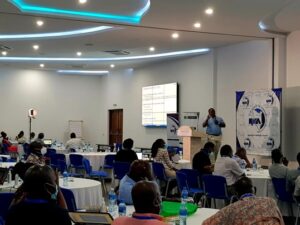
The National Rabies elimination strategy, launched in 2014, utilises a Step-wise Approach to Rabies Elimination (SARE) anchored on five main strategic pillars: mass dog vaccination, provision of post-exposure prophylaxis, improved rabies surveillance, public education and awareness and conducting operational research.
Tremendous progress has been made in more than five pilot counties mainly focusing on mass dog vaccinations, dog ecology studies, and public education. Despite these appreciable successes, there are some notable challenges that call for concerted One Health collaborative efforts. It is hoped such collaboration will ensure enhanced advocacy for resource allocation by counties aiming to implement the strategy through community driven vaccination efforts.
Dr. Mark Nanyingi attended the 15th World Rabies Day (WRD) in Malindi, Kilifi county where the theme was “Rabies: Facts Not Fear”. These celebrations were organised by the Kenya Veterinary Association in collaboration with the county government of Kilifi.


A series of field activities took place from 25th and 26th September 2021, where Dr Nanyingi worked closely with UN FAO, Directorate of veterinary services at national and subnational level, and other stakeholders, to:
- Develop and disseminate key messages on rabies prevention and control; with emphasis on mass dog vaccination, preventing exposures and encouraging people to seek appropriate post exposure treatment. The dissemination was done through banners, flyers and national/vernacular radios and reached about 300,000 people nationally.
- Vaccinate 646 dogs and 53 cats, spay 11 dogs, and neuter several cats (over 300 animals were attended to nationally).
By implementation of multisectoral one health efforts, Kenya has made great strides in the stepwise elimination of dog mediated human rabies. There is a great opportunity for HORN to establish more collaborations that will support the successful implementation of the strategy.
The WRD celebrations achieved the following outcomes:
-
- Strengthened community-based one health approaches in Rabies elimination.
- Enhanced public advocacy and awareness on rabies transmission, prevention and control.
- Shared research work and success lessons in combating and elimination of rabies in pilot counties.
- Identified challenges, established and created synergies and network of stakeholders involved in rabies control and prevention.
- Reinforced the need for one health workforce capacity building at subnational level through programme’s like FAO’s ISAVET
On 27th and 28th September 2021, the 55th KVA Annual Scientific Conference was held at Sandies Tropical Village Hotel, Malindi. The theme was: “Animal Resource Industry Driving the Sustainable Development Goal”, and 550 delegates (veterinarians, para veterinarians) attended the conference both physically and virtually.



Under the Epidemiology and Public Health session, Dr. Nanyingi made a plenary address on “A One Health multi-sectoral national strategy for Brucellosis prevention and control in Kenya”. His presentation focused on one health efforts in development of a National Strategy for the prevention and control of brucellosis in humans and animals in Kenya (2021-2040).
As part of HORN, Dr Nanyingi continues to provide technical support to the government of Kenya and the FAO in the realisation of this strategy, and also the realisation of two other key national one health documents that are ready for national launch: National One Health Strategic Plan for Prevention and Control of Zoonotic Diseases in Kenya (2021-2025) and National Strategy for the prevention and control of Anthrax in humans and animals in Kenya (2021-2036).
